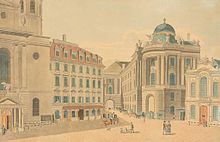Carl Schütz (copper engraver)
Carl Schütz (born November 2, 1745 Laibach [today Ljubljana ] or Vienna , † March 14, 1800 in Vienna) was an engraver , draftsman and architect. Especially his engraved vedute from the series “Collection de 50 vues de la ville de Vienne” are recognized as being of lasting importance.
Life

Schütz was trained as an artist and architect (under Johann Ferdinand Hetzendorf von Hohenberg ) at the Academy of Fine Arts Vienna from January 3, 1764 . Diverse talented and interested, he was active in different art fields. His work in etching and copperplate engraving was outstanding . He specialized in architectural drawings.
In 1787 the "Mappa von dem Land ob der Enns", consisting of twelve sheets, was published, engraved by Carl Schütz and described by Franz Müller. Another stab from Schütz affected Vienna 's Stephansplatz in Vienna after the urban development measures there had been completed - which had primarily included the demolition of smaller buildings. This work was presented to Emperor Franz II on the occasion of his accession to the throne in 1792 by a delegation from the city magistrate. Watercolors and drawings by Schütz can be found in the Vienna Albertina and the Vienna Academy Library, among others .
Since 1772 Schütz was a member of the Academy of Fine Arts (as an architect), later he also taught as a professor at the Imperial and Royal Engineering Academy . His wife Susanne, b. Fino (1749-1810), he married in 1773. She was the daughter of the court master Marcus Fino and died in a fall from the window.
"Collection de 50 vues de la ville de Vienne"


The most important works of the artist are the sheets he made in the collection of engravings "Collection de 50 vues de la ville de Vienne" (also: "Collection de cinquante vues de la ville de Vienne, de ses Fauxbourgs et de quelques uns de ses Environs") ), which was first published by Artaria in 1779 . In addition to Schütz, the artists Johann Andreas Ziegler , Laurenz Janscha and Jakob Alt were involved in the work, which contained 50 engravings (sheets) on the most important churches, palaces, public squares in the city of Vienna and the surrounding areas (the latter two only for the new editions ) involved. The vedute was colored in the then popular Aberle style . The initiative to produce these “painted brochures” came from Carl Schütz.
"The liveliness of the late baroque and rococo merges in these vedute cityscape and people to a unit of the highest expressiveness and visual impact."
The artists shared the work on the engravings: Schütz took on the architectural views of buildings and districts, Ziegler concentrated on the suburbs and the surroundings. The sheets were 12 by 16 inches. The collection appeared in several editions, the engravings were partially corrected in line with the changed views. This also applied to the clothing of the groups of people depicted in the drawings. On May 2, 1787, Schütz sold his 17 plates and the corresponding exploitation rights to the Artaria publishing house.
Web links
- Carl Schütz in the Vienna History Wiki of the City of Vienna
- Wikisource, Biographical Lexicon of the Austrian Empire
- Wikisource, ADB
Individual evidence
- ↑ The place of birth is disputed; the General German Biography refers to Laibach, the Biographical Lexicon of the Kaiserthums Oesterreich Wien
- ^ Carl Schütz in the Vienna History Wiki of the City of Vienna
- ↑ From March 1, 1792 to the end of the 18th century :, Volume 1 of: Memorabilien des Österreichischen Kaiserstaates , Sollinger, 1825, p. 102
- ↑ Reingard Witzmann, Sándor Békési, Wien Museum Hermesvilla (ed.), Beautiful Views: Die Famous Vienna Pictures by the Artaria Publishing House , Volume 337 of: Special Exhibition of the Wien Museum , Brandstätter , 2007, p. 13 (Snippet)
- ↑ Felix and Helga Czeike, Vienna: Art, culture and history of the Danube metropolis , DuMont art travel guide , ISBN 9783770143481 , DuMont Travel Publishing, 1999, p 27
- ↑ Günter Düriegl, Artaria & Co, Historisches Museum der Stadt Wien, The Artaria publishing house: Vedutas and everyday scenes from Vienna: May 28, 1981 to September 13, 1981 , self-published by the Vienna City Museums, 1981, p. 18 (snippet)
| personal data | |
|---|---|
| SURNAME | Schütz, Carl |
| ALTERNATIVE NAMES | Schytz, Karl |
| BRIEF DESCRIPTION | Austrian engraver |
| DATE OF BIRTH | November 2, 1745 |
| PLACE OF BIRTH | Vienna |
| DATE OF DEATH | March 14, 1800 |
| Place of death | Ljubljana |
